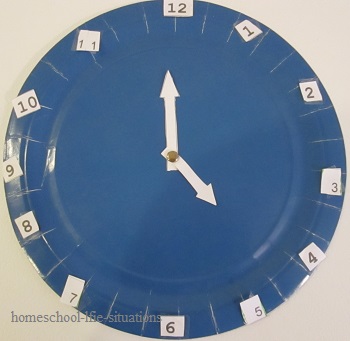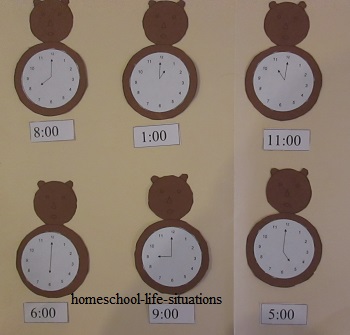Homeschooling Telling Time
Telling time seems pretty natural in a home setting. I am always asking my children, “What time is it?” Yet there is more to teaching. We need to teach our children how to read an analog clock. Teaching about calendars, and how to stay on schedule is also important.
We can make learning fun with hands-on projects and games. We can also read interesting books about telling time.
Teaching How to Read an Analog Clock
We live in the digital age. Most children can read a digital clock at an early age. It is also important to read an analog clock. An analog clock is a round clock. It starts with twelve at the top.

When my children were young we made a toy clock out of a paper plate. Here is how we made it;
Write the numbers one through twelve on the side of the plate. The number twelve is at the top of the plate, three is one quarter of the way around, six is at the bottom, and nine is three quarters the way around. Fit the other numbers in between.
Make clock hands out of thing cardboard. One hand is larger than the other. Attach the hands to the plate with a brad.
Teach your child to use the clock. Make sure that he knows that the hour hand is the short hand and the longer hand is for minutes. Also teach your child that there are sixty minutes in an hour, so each number represents five minutes.
Some clocks may have Roman numerals or pictures to represent the clock numbers. Teach your child the location of the twelve clock numbers and he will not become confused.
You can also make a folder game to teach your child the different between an analog clock and a digital. Draw analog clocks with different times. Write the corresponding digital times on rectangles. Attach the clocks onto a file folder. Place a strip of Velcro under the analog clocks. Attach the other side of the Velcro to the rectangles. Have your child match the correct times together.

Picture Books
My favorite picture book about telling time is The Clock Struck One by Trudy Harris. The book is based on the familiar nursery rhyme Hickory Dickory Dock. Each time the clock strikes the hour the cat chases the mouse. Each hour another animal or person joins the chase. Look in your library for more picture books about time.
Schedules and Calendars
When my children were young I had a printed schedule for our day. On the schedule I had times for when my child was to get up, do schoolwork, eat lunch, etc. I would use the schedule to make up story problems. I would say something like, "It is 10:00 now. In how many hours will we have lunch?" It is also helpful to have a toy clock handy when doing story problems. Your child can count the hours if he cannot do the math in his head.
Besides schedules we need to teach about the days of the week and the months of the year. We can start with nursery rhymes. Eventually we need to teach our children how to read calendars.
We were lucky in that our math curriculum (Saxon) taught about calendars in first, second, and third grade. My children learned;
- The days of the week
- The months of the year
- Doing math to find out someone’s age
- Finding out how many days until an important date
There Is More to Telling Time
For older students you can add history and science to your curriculum. For history teach about the different time pieces that were used. Show your children;
- a sundial
- a water clock
- a sand glass
- a gear clock
For science teach about how time is related to the phases of the moon and the rotation of the earth.
The Usborne Book of Knowledge has a time line of clocks. The explanations are simple. We used the book when my children were in elementary school.
We have another book about Time published by Milliken. It is for seventh through twelfth grade. Even though the book is for older students some of the concepts can be understood by younger children. I used the book to teach about moon phases, different clocks, and how calendars were made.
Telling time is an important skill. Have fun teaching it.
Leave Telling Time for Homeschooling Math
Return to the home page

New! Comments
Leave me a comment in the box below.